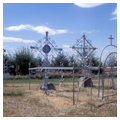The Hutmacher complex comprises two adjacent farmsteads, the Frank and Veronica Hutmacher farmstead and the Valentine and Francis Hutmacher homestead, the latter of which is only foundations now. Both were constructed in a form that originated in the Black Sea region of Russia and Ukraine. The sandstone slab buildings of the Frank and Veronica Hutmacher farmstead belong to a distinct and surprisingly durable folk culture. In addition to the use of coursed ashlar sandstone and clay mortar used here at the Hutmacher complex, German Russian methods of construction employed by the immigrants elsewhere in North Dakota included rammed earth, puddled clay, and unfired batsa brick. The rooms in the Hutmacher house align along a single east-west axis with an entrance vestibule recalling the tradition of a vorhausel (forehouse). Unhewn Badlands cedar roof rafters rest atop the stone walls and on a cottonwood ridge beam referred to as an erstbaum. The entire roof assembly is covered by branches, straw, and clay. Beehive-shaped clay-coated chimneys visible in two locations originally served cast-iron stoves. Interior features include a Lieberherrgottseck, or God’s Corner shrine, and a familiar palette in distinctive wall colors of deep pink, blue, and pale green affirm the continuity of German Russian traditions and folk tastes. The house remained in use as a residence until the 1960s.
Utilizing modest materials close at hand, German-speaking immigrants from the Black Sea region of Russia and Ukraine adapted traditional housing forms to create economical shelter on the Great Plains, a resource-poor context. Such ethnically distinct vernacular traditions are now becoming well known at the same time as they are rapidly disappearing. The Hutmacher site has been documented for the Historic American Buildings Survey (HABS), and the Hutmacher house is undergoing reconstruction as an ongoing field school project managed by the organization Preservation North Dakota. Nearby is St. Edward’s cemetery (115th Avenue SW), which includes traditional cross-shaped iron grave markers.















